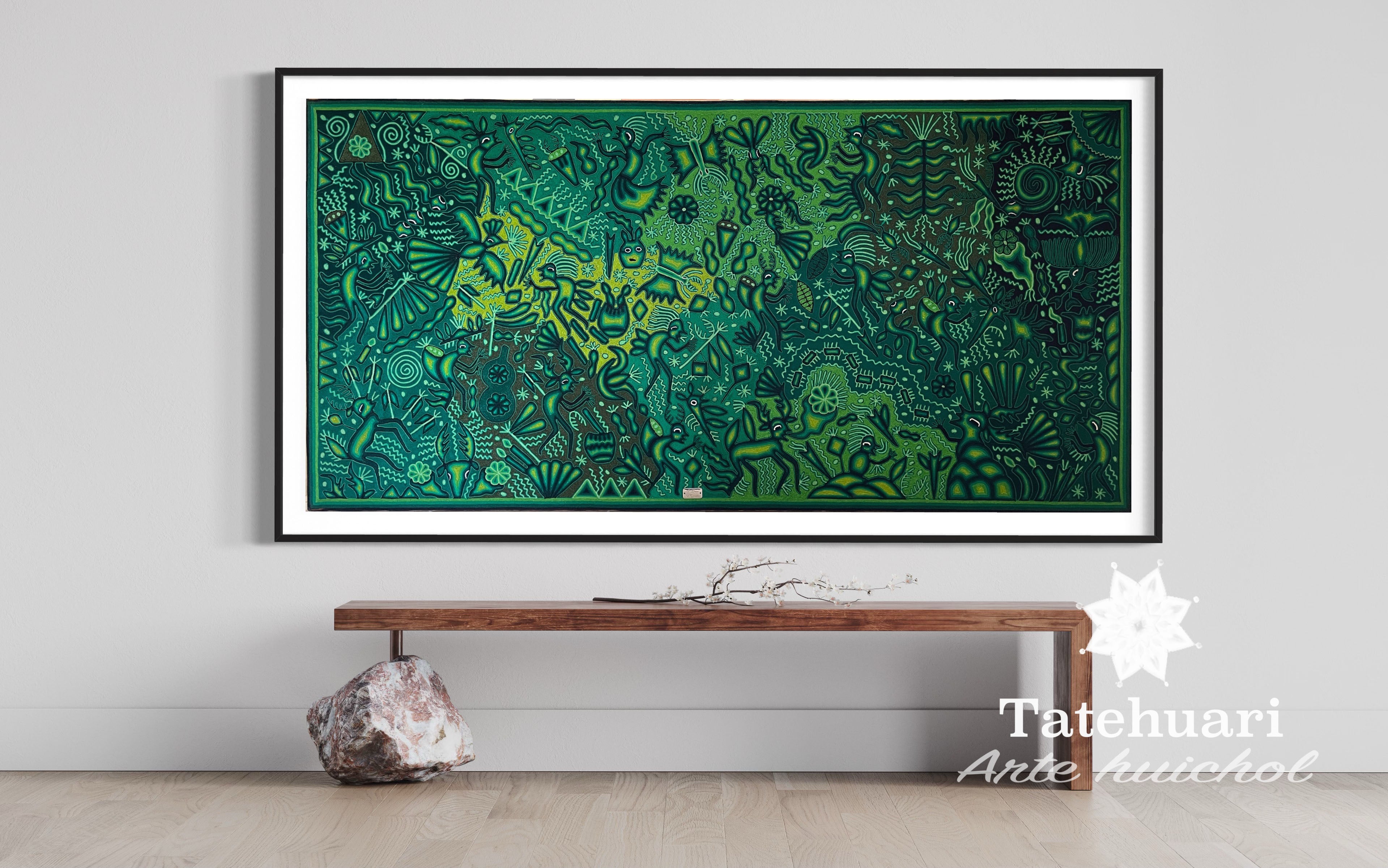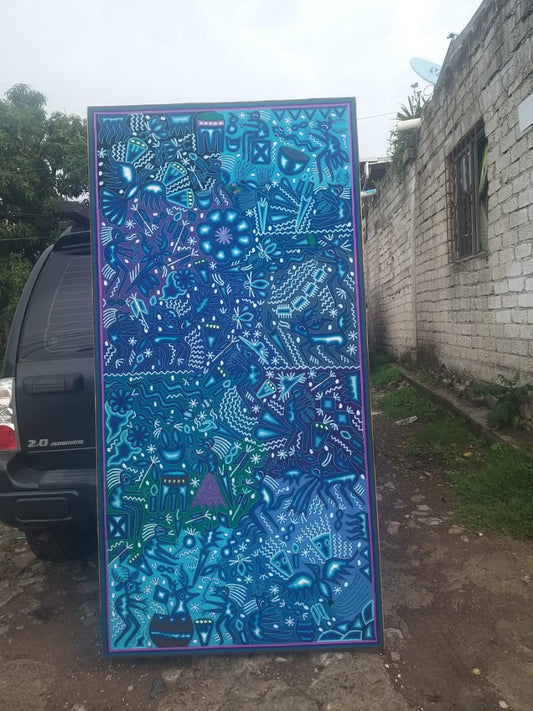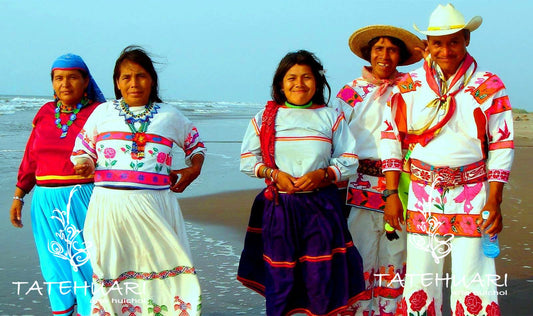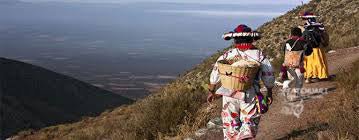
Who are the Huichols?
The Huichols are part of the Mexican people. They currently live in the north of Jalisco, part of Nayarit, Zacatecas, Durango, and San Luis Potosí, up there in the sierra that crosses these states. They live quite isolated and they keep up to now very old customs, of which they are very proud.
The Huichols are one of the ethnic groups that have managed to remain "pure" since the time of the Spanish conquest. They refer to themselves as “Wirrárrica” or “Wirraritari” (plural). We do not know if the word "Huicholes" is a variation of "Wirrárrica" or "Wixarika". The mountains are inhabited by the mystical culture of the Huichol community; in which enigmatic worlds are constantly created whose recurring protagonists are moons, suns, trees, labyrinths, spirals, mountains and cosmic oceans that are tirelessly expressed in the art, religion and customs of the Huichols. It is a town of Huichol artists that has kept away from external influences through the centuries. They come from the central West of Mexico, where the Huichols live in remote places of the Sierra Madre Occidental in the States of Nayarit and Jalisco.
Initiation of ritual art.- Because it belongs to the specific religious practice of an indigenous group, the Huichol has different dimensions from contemporary art that we usually find in museums and galleries. The Huichol world is divided into three universes: that of mythology, the Huichol maintains that life began in the ocean; the one referring to corn, where daily life and Huichol traditions take place and the one that has to do with mysticism, which reveals the Huichol world and the Huichol art of their rituals that distinguishes them and gives them identity as a Huichol community.
Although the origin of this fascinating Huichol ethnic group is uncertain, what is indisputable is that during the Conquest period, many survivors of various indigenous peoples, mainly the Huichol, fled into the Sierra Madre Occidental to escape the wake of the of destruction left by the Spanish troops.
Huichol Art is a form of writing, since through creations, the Huichols tell us their stories and myths. In each craft, the Huichol leave a piece of their life. Currently, it can be said that there is no other ethnic group in Mexico that preserves its beliefs, cults and traditions as deeply as the Huichols.
We can see among its artistic pieces figures lined with beads that represent a large number of shapes and animals, the yarn tables that offer us a window into its mystical - magical world and accessories finely made with "beads and microbeads", which surprise for their beauty, among them you can find bracelets, necklaces, earrings, pectorals and endless accessories made with tiny chaquira beads
Among the most beautiful and aesthetic cultural and craft elements of Huichol art are the yarn paintings of the Huichol marakame (shamans). In these pieces they recount daily events of their lives, telling us through a painting a whole wonderful story full of mysticism and bring us closer to the beginning of time.
In the Huichol religion, everything exists thanks to the visionary experience of the initiates and their great effort to obtain "the gift of seeing" or nierika. The art of the NIERIKA collection of yarn boards is the work of various artists or artisans, who follow these ritual paths, and have left us in these pieces parts of their personal search.
Huichol Art has an enigmatic beauty that takes us through mythical paths and brings us closer to the beginning of time in the Huichol Culture, but it is not just about Huichol myths drawn by Huichol artists who draw them on yarn or thread, in religion of the Huichol, the world exists thanks to the visionary experience of the Huichol initiate and his effort to obtain the "nierika" or "gift of seeing". Thus, for the Huichol, Huichol artistic creation has a cosmogonic dimension.
For the Huichol, the world has a sacred dimension into which the mara'akame (shaman) penetrates through sleep, establishing a link between the world of the gods and the profane. Customs: If the Huichol has fallen ill due to a curse, the mara'akame must “clean” the sick person with feathers while spraying tobacco smoke all over his body and then suck the object that causes the illness with his mouth; when the patient has lost the kupúri (a part of the Huichol soul that is located in the upper part of the head) the mara'akame must go in search of it to put it back in its place, but when it has been stolen by a sorcerer, the Huichol mara'akame must confront him to recover it.
It is due to the importance of the Huichol sacred world and its intrinsic relationship with the Huichol way of life, that hundreds of stories that narrate the mythology and cosmogony of this fascinating culture are always expressed in their art. All those Huichol crafts that are not oriented to commercial purposes, are created to narrate the diverse religious experiences of the Huichols in each of their authors, becoming fantastic pieces of beautiful colors and unimaginable figures that can only be conceived in the mind. of the Huichol artist.
The ancestral legend: The Huichol legend relates how, at the beginning of time, there was no other light in the world than that of the Moon, this being a great inconvenience for man. The elders and those who possessed the knowledge then met to discuss the way to bring more light to the world, they begged the Moon to send them her only son, a one-eyed, lame boy. At first the Moon objected, but in the end she gave her consent. Then, they dressed the boy with ceremonial clothes, which consisted of sandals, feathers (sandals), and backpacks to store tobacco; then they gave him a bow and arrows as a weapon and painted his face, to then throw him into an oven, where the fire consumed him entirely. However, the boy resurrected and ran underground, and to everyone's astonishment: five days later, the Sun appeared. When the Sun spread its light on the earth, all nocturnal animals (jaguars and mountain lions, coyotes , foxes and snakes) were greatly annoyed and shot their arrows at the day star.
The heat and the rays of the Sun were intense and blinded the animals of the night, forcing them to hide in dark caves, puddles and trees; if it had not been for the squirrel and the "pitorreal", the Sun would not have been able to complete its first tour of the sky. These were the only two animals that defended the Sun; they would have preferred to give their lives than allow the Sun to die, and at sunset they left a bit of "tesguino" in view so that the Sun could pass. The jaguars and wolves killed the squirrel and pitoreal in the end, but, even to this day, the Huichol make offerings to these heroes and call the squirrel “Father.”
Productive Activities: Apart from the sale of their handicrafts, the main productive activities of the Huichols are basically those necessary for their livelihood: hunting, fishing, and agriculture. Its main crops are corn, squash, zucchini, amaranth, beans and chili. They still plow the land using wooden plows, and when the terrain allows it, they use a team of oxen. All agricultural land is communal property. There is a temporary migration among the Huichols.
Their religious, political and economic life is organized in such a way that they can emigrate from one place to another and then return to their places of origin. There are Huichol settlements in Tepic, Calvillo, Fresnillo and Guadalajara; although it is not clear if these settlements are temporary or permanent.
#vacation #huicholes #Art huichol #Craft Huichol #Handicrafts mexican




